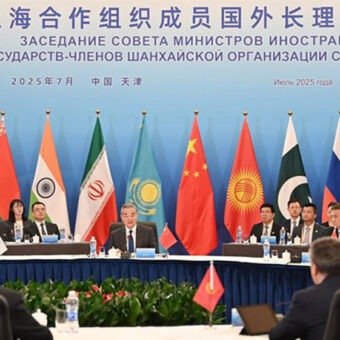SCO summit in China: economic cooperation on the agenda
A general expectation exists, that the SCO and BRICS will become closer in some form or another. Exactly how, given that the two organizations serve different sets of countries, arguably with different sets of needs, is the open question. We expect, based on the current SCO meeting, that a SCO bank, similar to the BRICS bank, will be established, or perhaps an existing bank will be chosen to fulfill the SCO’s requirements, as the NDB is expected to meet the BRICS’ requirements.
The following article from BRICS Analytics outlines the potential convergences between the two organizations. Lula from Brazil is requesting an extraordinary (and urgent) summit of BRICS. He states that the US tariff regime is aimed at undermining multilateralism and multipolarity. This is indeed a BRICS problem (war on BRICS), but it is also a SCO problem. What is it that we don’t understand yet in terms of a divide-and-conquer strategy? Lula has defined that BRICS countries are being picked off one by one. We cannot argue with that concept.
There are two schools of thought in terms of growth of the Global South. The first is that these organizations need to remain separate entities, forming an array of change agents, rather than a single, unified bloc that can be attacked as one. This thought downplays the strength of a strong bloc acting in concert. The second is the view outlined in this article, that the organizations are synchronous and must become much closer.
Essentially, between the BRICS and SCO, we talk about economic cooperation and an array of issues such as anti-terrorism action. Is the time now right to talk about military cooperation? The first warships are in and crossing the Panama Canal in, what we hope, is only a force projection from the US against Venezuela. I fear though that this hope is misplaced and we may be looking at yet another regime change operation, this time with the old gunboat ‘diplomacy’. Then we have the extremely violent clashes defined to be yet another regime change or similar type operation in Indonesia. Indonesia is the first Southeast Asian nation who joined the BRICS block formally in the beginning of this year. Vietnam followed.
What is clear, is that we are looking at total war on many fronts. The US cancellation of visas for the Palestinian groups to attend the September UNGA meeting, is part of this total war. Greater Israel must be established for the hegemon to own West Asia and what is referred to as the Middle East. Rubio’s Shameful and Illegal Interference With the UN. w/ Prof. Jeffrey Sachs & the Judge
We are now in the territory of a deathly war between two world orders, one falling and we’re moving into a post-West world order, and one rising with Global South power.
—
The Shanghai Cooperation Organization (SCO) summit that is starting imminently in Taijing, China may bring a number of breakthroughs in transforming the bloc in the direction of prioritizing economic cooperation. One of the possible decisions at the summit may be the launching of an SCO development bank that would expand the array of Eurasia’s development institutions. Another important turn in SCO’s evolution this year will be the expansion in the SCO+ format that is to include representatives of regional and international organizations. These and other developments point in our view to a rising similarity in the transformation experienced by the SCO and BRICS – something that we believe will be conducive to forming a closer SCO-EAEU-BRICS partnership that has been widely discussed within the Eurasian circles in recent years.
Throughout the past several years, the SCO, like the BRICS grouping, was in expansion mode. In 2017, the SCO widened its ranks to include India and Pakistan, Iran joined the group in July 2023, and Belarus in July 2024. In the case of the SCO, as well as BRICS, apart from the expansion of core membership, there was also the creation of a partnership belt. Following the expansion of BRICS and the SCO over the past several years, both platforms are now broadly comparable in terms of the number of countries in their core and partnership belts. Both now have 10 developing economies in the core, with the partnership belt in BRICS currently consisting of 10 members (together with Vietnam, that joined the partnership belt in the summer of 2025) and several more that are yet to accept the invitation, while in the case of SCO the number of dialogue partners amounts to 14 countries.
Apart from the synchronicity in the expansion mode across the two blocs, there is also a rising convergence between the SCO and BRICS in terms of membership in the core and the partnership belt. At this stage four BRICS core members – India, Iran, China and Russia – are also members of the SCO core. The BRICS core now also includes two dialogue partners from the SCO – the UAE and Egypt (three in case Saudi Arabia becomes a full-fledged BRICS member). The newly created BRICS partnership belt also included two SCO core members from Central Asia – Uzbekistan and Kazakhstan – as well as one core SCO member from Europe, namely Belarus. Also, some of the SCO core members and partner economies in recent years were granted membership in the BRICS New Development Bank – specifically Uzbekistan (core member of the SCO) and Bangladesh (applied for dialogue partner/observer in the SCO).
With SCO expanding to cover more Eurasian economies, the bloc launched an SCO+ format in 2024 that is to be further broadened in terms of its scope this year during the SCO summit in China. The Chinese authorities expect nearly 30 representatives of countries, regional blocs and international organizations to attend the SCO+ meetings during this year’s SCO+ summit. The launching of this SCO+ format is line with our calls to create an SCO+ platform for the regional arrangements in Eurasia back in 2018 and further in 2022 and 2024. This emerging SCO+ platform bears resemblance to the evolution of the BRICS+ format whose theoretical foundations we also developed in the beginning of 2017 and whose practical implementation was launched by China in the fall of 2017.
As we have noted in the past, the convergence in the modalities of operation of BRICS and the SCO blocs – as evidenced by the launching of the SCO+ format (similar to BRICS+) as well as the possibility of the creation of a SCO development bank (similar to the BRICS NDB) – is conducive to greater coordination and alignment between these two platforms going forward. It also lays the groundwork for the implementation of the stated goal of forging closer cooperation within the EAEU-SCO-BRICS triad.
This greater alignment between the three blocs may shed light on the further evolution in the integration impulses across Eurasia and the Global South. In particular, the EAEU-SCO-BRICS platform may bring on board the regional integration blocs from outside of Eurasia (such as Mercosur or AU/AfCFTA) leading thus to the creation of a broader BRICS+ platform for regional integration arrangements. Another possible implication is that BRICS institutionalization may follow in part the patterns of institutionalization within the SCO and the EAEU, including with respect to the creation of a Commission/Secretariat.












The last SCO Summit in Kazakhstan was similarly overhung with war clouds. Around both, historic aggression against Iran had just taken place, and more was expected. Pepe wrote a year ago, “The SCO has evolved into serious geoeconomic cooperation, discussing in detail, for instance, supply chain security issues.” So the… Read more »
I’m minded of Chinese proverbs on maintaining goal-directed motion facing adversity. Much of BRICS’ economic momentum and potential was stymied; they’re now working to compensate via the SCO. This certainly appears the seminal meeting of the year, as Kazan was in 2024. It is a pity Lula didn’t show up,… Read more »